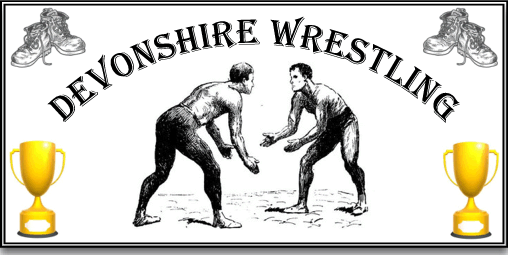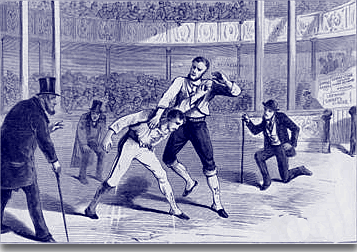
Devonshire Wrestling along with Cornish Wrestling are probably the earliest forms of this sport, although the northerners will dispute this. In Devon and especially upon Dartmoor wrestling had a very strong following and noted champions. Writing in 1708, Charles Vancouver gave his description of the sport in the following terms:
“The athletic exercise to which these people are mostly addicted, is that of wrestling. This is pursued with great fervour and emulation, by the young farmers and peasantry in the country. It is common on these occasions for a purse of six, eight, or ten guineas, to be made by gentlemen fond of promoting this play, and a day is appointed for its being wrestled for, generally near some large village or market town. The lists are prepared by a ring formed with stakes and a single rope, from fifteen to twenty yards in diameter, and in which it will appear that the winner of the purse must toss or throw down five of his adversaries. There seems to be no regulation with regard to the hold they take of each other. The collar, arm, or any part above the waistband, that most conveniently presents to the combatants during the contest, which sometimes continues from ten to fifteen minutes, and in which is displayed much activity, strength, and adroitness, whilst the shins of the party are often found streaming with blood from the sharp and violent blows they receive from each other, but which on no account are ever permitted to be given above the knee.”
The unique wrestling ‘costume’ of both Devon and Cornwall comprised of breeches and a short. loose wrestling jacket. Devonshire wrestlers also wore hard shoes with which, as Vancouver noted, it was permissible to kick the opponent anywhere below the knee. Vancouver then goes on to explain how the contests were organised:
“In the outset of play, every man who becomes a standard for the purse, must first throw two men on their back, belly, or side; eight of these standards must be made from the primary competitors for the single play; and when the standards are thus made, they each receive a crown. These eight playing, four of them must fall; when the still standing two enter to decide the purse, and the second best man, or he who is last thrown, usually receives about one in five upon its amount. Three tryers or conductors of the lists are appointed, who decide all disputes immediately, and without appeal“.
And if you understood that lot then ‘you’m a better man than I Gungadin’. What I think he was trying to say was that a player had to give his first opponent a fair fall as judged by the ‘tryers’ or ‘sticklers’ (he’s a stickler for punishment – sound familiar?). The reason they were called ‘sticklers’ is because each one carried a large stick which was mostly used to keep spectators out of the fight arena. Having done so he then fought another ‘single’ and if this adversary was also given a fair fall then the winning player was deemed to have made a ‘standard’. Once the required number of standards was reached the sticklers would then match the contestants for the ‘double’ round, similarly this progress to the ‘triple’ round and so on until an overall winner was reached. The runner up usually received 20% of the purse with the remaining 80% going to the winner. Vancouver then goes on to explain the contest times:
“The play generally begins between two and three o’clock in the afternoon, and so well matched are the combatants that the victor is frequently not declared till after midnight; in which case the ring is properly lighted, and the same precautions are continued during the whole time to secure fair, and prevent foul play“.
To put this into a Dartmoor context, and knowing the hardiness of the moorfolk it is not surprising that Vancouver comments on the following:
“The moor-men are celebrated for their hardiness, in bearing excessive kicking upon their shins. The ill effects which might be expected to result from such violence, is very soon carried off by their excellent habit of body, and the peculiar temperament of their constitutions“.
Writing in the 1890’s, Baring Gould gave his childhood memories of Devonshire wrestling:
“The former forbore from kicking (Cornwall) whereas kicking, and that with shoes specially hardened for the purpose, was allowed to the Devonian. The combatants had their legs swathed in hay-bands (skillibegs). The great achievement of the wrestler was to “show the white horse” This consisted in elevating his antagonist over his shoulder and flinging him on the ground upon his back. Too often the result was fatal; the spine was either broken or so severely injured that paralysis ensued“.

Devonshire Wrestlers
The annual round of wrestling matches mainly occurred in the summer months and would take place at inns or fairs. Moretonhampstead was one of the celebrated venues on the moor but others were: Ashburton, Cornwood, Okehampton, and Tavistock. These were where the major contests took place and which the ‘names’ or noted wrestlers would attend. In 1824 it was reported that between 6 and 7,000 people attended a ‘strong’ contest that was held at Okehampton’s White Hart inn where the longest bout lasted 1 hour and 56 minutes. In 1825 another large contest took place which again had spectators number in the thousands, this event even had a band playing between bouts. But smaller contests took place across the moor, in 1789, the reverend John Swete, states that on his journey:
“thro Two Bridges, between six and seven We found the Fair, at it height, in point of revelry and pastime – the Women, however not yet emboldened by use, had in great measure withdrawn, and the amusements of the men seem’d to be confined to Wrestling and drinking“.
In 1842 it was reported that; “Henry Bond of Throwley, who won third prize at Moretonhampstead, and first prize at North Bovey this week offer to play the best of three fair back falls for five sovereigns, with any man in England of his weight (8st. 5 lbs.) and will give or take 5lbs. in weight.” So as you can see the wrestlers were not all Goliaths rippling with muscles as they are today.
Some of the ‘noted’ Dartmoor wrestlers were William Cann of Throwleigh, John Bolt of Cheriton Bishop, and a man called Heyler from Meavy. The injuries sustained during bouts ranged from the commonly broken collar bones and arms to the fatal, in 1865 a contestant dropped dead at a contest in Winkleigh. For many years people had suggested that the ‘kicking’ element of the Devonshire style was, “nasty, brutish. work”. The Cornish wrestlers had always resented the ‘kicking’ as in their style it was prohibited and this always showed itself at inter-county contests. In 1826 at one such event it was decided to allow the contestants to wear leg padding should they wish. But despite this every time a Devonshire wrestler kicked his Cornish opponent the contingent from west of the Tamar hissed and booed. During this contest, Abraham Cann, who was champion of England wrestled the Cornish Champion, a man called Polkinghorne. During the contest it was reported that Cann, who was only wearing a shoe on his right foot, “seized his opponent with his left hand, instantly making good his hold, planted some most terrible kicks which made his opponent wince, he kicked with the force of a sledge”. In the third turn it appears that Polkinghorne was almost choking Cann during which it was reported, “the sledge of Cann worked with the regularity of a pendulum, telling with the most terrible effect upon the legs of his opponent”.
By the 1860’s the Devonshire style of wrestling was dying out with one of the last contests being held at Moretonhampstead in 1877. It appears that attitudes to the kicking were changing and along with spreading corruption the sport gradually died out, in 1917 it was reported that Devonshire wrestling had been subsumed or incorporated into the Cornish style.
Reading List.
Porter, J. H. 1989 Decline of the Devonshire Wrestling Style, Transactions and Reports of the Devonshire Association, Vol. 121, Devon. Ass., Exeter.
Swete, J. 2000 Travels in Georgian Devon – Vol. IV, Halsgrove, Tiverton.
Vancouver, C. 1969 General View of the Agriculture of the County of Devon, David & Charles, Newton Abbot.
 Legendary Dartmoor The many aspects past and present of Dartmoor
Legendary Dartmoor The many aspects past and present of Dartmoor

One comment
Pingback: Celebrity Ancestor - Geneageek